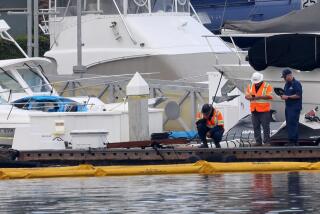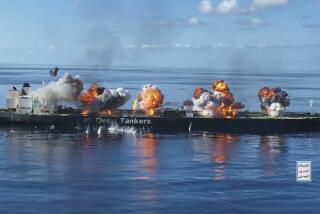Fire kills 14 Russian sailors aboard deep-sea submersible as speculation swirls
Reporting from Moscow — A fire on one of the Russian navy’s deep-sea submersibles killed 14 sailors, the Russian Defense Ministry said Tuesday without giving the cause of the blaze or saying if there were survivors.
The ministry didn’t name the vessel that caught fire Monday. Russian news media reported it was Russia’s most secret submarine, a nuclear-powered vessel designed for sensitive missions at great ocean depths.
The Defense Ministry said in a statement that the fire broke out while the submersible was measuring sea depths in Russia’s territorial waters and the vessel was at the Arctic port of Severomorsk, the main base of Russia’s Northern Fleet, on Tuesday. An investigation was underway, it said.
The ministry said the fire was put out due to the self-sacrifice of crew members but didn’t say what is thought to have started it. It didn’t say how many people were aboard the submersible or if there were sailors who survived the fire.
The ministry’s statement said the submersible is intended for studying the seabed, but didn’t give its name or type. Russia’s RBC online news outlet reported it was the nuclear-powered AS-12 Losharik.
The Losharik, which entered service in 2010, is the most advanced and most obscure Russian submarine. It’s named after a Soviet-era cartoon character, a toy horse made of small spheres.
The name is apparently explained by the unique design of its internal hull, which is made of several titanium spheres capable of withstanding high pressure at great depths.
In 2012, the Losharik was involved in research intended to prove Russia’s claim on the vast Arctic seabed. It collected samples from a depth of 8,202 feet, according to official statements at the time. Regular submarines can typically dive to depths of up to 2,000 feet.
Russia’s grand plan to modernize navy is tripped up by economy »
Some observers speculated the Losharik was capable of going as deep as 19,685 feet, but the claims couldn’t be independently confirmed. Analysts suggested that one of its possible missions could be disrupting communication cables on the ocean bed.
The Losharik is carried under the hull of a mother submarine, the nuclear-powered Belgorod.
Russian news reports said that while the Losharik officially belongs to the Northern Fleet, it answers directly to the Defense Ministry’s Department for Deep-Sea Research, reflecting the high sensitivity of its missions.
The Russian navy also uses Priz-class and Bester-class deep-water vehicles, which have hulls built of titanium and are capable of operating at a depth of 3,281 feet. They have a crew of two and are primarily intended for rescuing submariners in case of incidents. Such vessels are transported to the area of operation by a carrier vessel and can operate autonomously for up to 120 hours.
The blaze marks the deadliest Russian naval incident since 2008, when 20 died after a firefighting system was accidentally initiated while the Nerpa nuclear-powered submarine of Russia’s Pacific Fleet was undergoing trials.
In the deadliest naval incident in post-Soviet Russia, the Kursk nuclear submarine exploded and sank on Aug. 12, 2000, during maneuvers in the Barents Sea, killing all 118 crew members.
More to Read
Sign up for Essential California
The most important California stories and recommendations in your inbox every morning.
You may occasionally receive promotional content from the Los Angeles Times.










